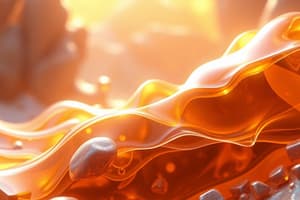Podcast
Questions and Answers
What can be inferred about chain flexibility in molecules?
What can be inferred about chain flexibility in molecules?
- Longer chains always have higher flexibility.
- It is directly proportional to the molecular weight.
- It depends on the steric hindrance within the molecule. (correct)
- There is no relation to molecular dipole moments.
Which factor does NOT affect the dipole moment in a CH3-CH2-X configuration?
Which factor does NOT affect the dipole moment in a CH3-CH2-X configuration?
- The spatial arrangement of the molecule
- The number of hydrogen atoms attached
- The length of the carbon chain (correct)
- The electronegativity of atom X
Hydrogen bonds are primarily influenced by which variable?
Hydrogen bonds are primarily influenced by which variable?
- The size of the molecule
- The electronegativity between atoms (correct)
- Hydrophobic interactions
- Ionic bonding strength
Which of the following statements about molecular composition is accurate?
Which of the following statements about molecular composition is accurate?
In a molecular structure, what role does chain flexibility play?
In a molecular structure, what role does chain flexibility play?
What is a characteristic of molecules with higher chain flexibility?
What is a characteristic of molecules with higher chain flexibility?
Which property is least likely to be affected by hydrogen bonding?
Which property is least likely to be affected by hydrogen bonding?
Which of the following best describes the relationship between chain length and flexibility?
Which of the following best describes the relationship between chain length and flexibility?
What is the primary function of polymers?
What is the primary function of polymers?
Which of the following statements is true regarding the properties of polymers?
Which of the following statements is true regarding the properties of polymers?
How do the molecular weights of polymers typically affect their properties?
How do the molecular weights of polymers typically affect their properties?
What can be said about the relationship between polymer structure and its applications?
What can be said about the relationship between polymer structure and its applications?
Why are some polymers more resistant to heat than others?
Why are some polymers more resistant to heat than others?
What characteristic distinguishes thermosetting polymers from thermoplastics?
What characteristic distinguishes thermosetting polymers from thermoplastics?
What is the main disadvantage of certain polymers when exposed to UV light?
What is the main disadvantage of certain polymers when exposed to UV light?
Which property of polymers is significantly affected by their ability to crystallize?
Which property of polymers is significantly affected by their ability to crystallize?
In what way do fillers affect polymer properties?
In what way do fillers affect polymer properties?
Which factor is least likely to influence the viscosity of a polymer melt?
Which factor is least likely to influence the viscosity of a polymer melt?
Flashcards
Chain flexibility
Chain flexibility
The ability of a molecule to bend or twist at different points along its length.
Molecular composition
Molecular composition
The types and arrangement of atoms within a molecule.
Polymer
Polymer
A large molecule made up of many repeating smaller units called monomers.
Monomer
Monomer
Signup and view all the flashcards
Polymerization
Polymerization
Signup and view all the flashcards
Addition Polymerization
Addition Polymerization
Signup and view all the flashcards
Condensation Polymerization
Condensation Polymerization
Signup and view all the flashcards
Polymer Structure
Polymer Structure
Signup and view all the flashcards
Tensile Strength
Tensile Strength
Signup and view all the flashcards
Elasticity
Elasticity
Signup and view all the flashcards
Thermal Stability
Thermal Stability
Signup and view all the flashcards
Toughness
Toughness
Signup and view all the flashcards
Study Notes
Polymer Structure and Properties
- Polymers are large molecules made up of repeating units called monomers.
- The structure of a polymer significantly impacts its properties. Chain flexibility, molecular composition, and hydrogen bonding play crucial roles in determining how the polymer behaves.
Chain Flexibility
- Chain flexibility is a key factor in polymer properties.
- Flexible chains allow for greater conformational changes, leading to more amorphous or less ordered structures.
- Rigid chains limit motion, and tend to be more crystalline.
Molecular Composition
- The composition of the polymer, including types of monomers, influences its properties.
- Table 2.10 shows dipole moments for various groups in a specific structure (likely CH3–CH2–X). These dipole moments affect intermolecular forces and overall polymer behavior, influencing properties.
Hydrogen Bonding
- Hydrogen bonds can have significant effects on polymer properties, influencing the overall structure and behavior.
- These interactions between molecules can contribute to chain ordering and aggregation, potentially affecting flexibility.
Further Detail (from the image, likely a figure)
- Figure 2.12 likely illustrates hydrogen bonds, showing their arrangements within a polymer structure.
- The diagram likely highlights the critical role of hydrogen bonding in determining the overall polymer properties and structure. This would relate to how different monomers interact and what impacts these forces have.
Studying That Suits You
Use AI to generate personalized quizzes and flashcards to suit your learning preferences.




